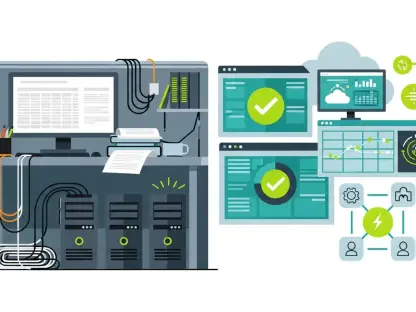A wave of large, federally insured credit unions has moved beyond traditional confines just as the National Credit Union Administration has stumbled into a leadership crisis that unsettled oversight and blurred policy direction across consumer protection, fintech, and consolidation. The pivotal question is whether institutions still grounded in cooperative purpose can balance modernization with mission, particularly as stablecoin pilots, bank acquisitions, and fee practices test their public privileges and spark calls for tax recalibration. In this vacuum, industry lobbying intensified, state lawmakers started to experiment with guardrails, and stakeholders recalculated the trade-offs between innovation and accountability. What emerges is not a simple split between credit unions and banks, but a deeper argument over how far a not-for-profit charter can stretch before its advantages demand new conditions.
Governance Shock and Regulatory Drift
A Board in Limbo
The NCUA entered a rare governance limbo when the removals of Tanya Otsuka and Todd Harper triggered litigation that left the three-seat board without a reliable quorum and concentrated effective voting power in Chairman Kyle Hauptman. In practical terms, this dispute slowed reviews of headline bank acquisitions by credit unions, delayed clarity on rulemakings tied to transparency and executive pay, and chilled responses to evolving risks in areas like liquidity, interest rate exposure, and third-party fintech partnerships. The uncertainty deepened after a district court ordered reinstatement only to be stayed by an appeals panel, prompting an emergency petition to the Supreme Court that now hangs as a procedural hinge for the agency’s agenda and credibility.
The impasse has mattered beyond bureaucratic charts because it shaped how institutions interpreted risk-taking, disclosure, and strategic growth in the near term. Without predictable timelines for mergers or clear signals on forthcoming standards, larger credit unions gained room to push forward with bank deals and technology pilots, while smaller, community-rooted peers faced a moving target for compliance planning. Market participants read tea leaves—public remarks from Hauptman, staff bulletins, and enforcement posture—to guess at where guardrails might land. That guessing game raised the stakes of legal resolution; a clean board reset would re-center rulemaking authority, but a prolonged split would leave stakeholders grappling with interim norms set more by rhetoric and momentum than by formal vote.
Innovation First, Disclosure Later
Chairman Hauptman’s modernization emphasis—most notably his favorable framing of stablecoins as dollar-backed “chips” that could speed settlement—signaled a regulatory tilt toward efficiency gains over immediate transparency mandates. He paused or shelved projects he viewed as fueling sensationalism, including high-profile fee reporting that dominated headlines, and instead highlighted crypto guidance and real-time rails as value propositions for members. The pivot marked a sharp departure from Harper’s transparency-first doctrine, which sought to curb harmful practices through sunlight and standardized data. In this moment, policy sequencing—modernize now, disclose later—became as consequential as the rules themselves.
Critics countered that innovation divorced from disclosure mispriced consumer risk and eroded trust at the precise moment when the sector needed to justify special tax treatment and a lighter statutory burden. The concern was not innovation per se but the absence of parallel commitments to member-facing accountability, especially where fees and executive compensation intersected with brand expansion and acquisitions. Supporters of Hauptman’s approach argued that runways for experimentation were essential for competitiveness, and that premature comparisons with banks obscured structural differences in ownership and capital. Yet the durability of this stance hinged on ongoing litigation and potential board realignment, since a restored quorum could quickly reweave transparency into the modernization plan.
Mission, Fees, and Accountability
Overdraft Revelations and the Rollback
Under Harper’s chairmanship, the NCUA required large credit unions to report overdraft data, and the results jolted policy circles: institutions controlling roughly a tenth of deposits accounted for an outsize share of overdraft revenue, an imbalance that raised questions about who bore the cost of convenience and liquidity. For advocates, the data made visible a regressive fee architecture that often hit households already on tight margins, contradicting the sector’s promise of fair access. The reporting also created market pressure, as members, journalists, and policymakers could juxtapose credit union performance against banks and against peer institutions that had reformed fee schedules or redesigned accounts to prevent repeated charges.
When Hauptman discontinued the reporting, he contended that the numbers were misinterpreted and weaponized by headlines that failed to reflect differences in product mix, membership demographics, and the absence of bank-style equity compensation as a retention tool. The rollback satisfied industry leaders who saw data without nuanced context as a reputational hazard, but it also narrowed the lens through which members could evaluate whether their co-op met mission. The timing mattered: as consolidation accelerated and technology investments rose, losing a common disclosure baseline left consumers with fewer reliable signals about cost and value. In this space, the argument over overdrafts evolved from a single-fee debate into a proxy fight over the transparency standard appropriate for tax-advantaged, member-owned lenders.
Executive Pay and Signs of Drift
Executive compensation moved from an inside-baseball metric to a lightning rod as anecdotes surfaced: a private jet at a major institution, stadium naming rights by a well-known intelligence community credit union, and a small New York shop paying a seven-figure salary while edging toward insolvency. Harper pushed for public reporting of top executive pay at federally chartered institutions, arguing that transparency would illuminate whether member resources tracked mission outcomes such as better pricing, access, or resilience. Trade groups fired back that any dollar-for-dollar comparison with banks distorted reality because credit union executives cannot receive equity compensation, making cash-heavy packages look inflated relative to bank peers whose total pay often leans on stock.
The deeper critique, voiced by analysts like Aaron Klein, centered on alignment and accountability: without routine disclosures similar to Form 990s, the largest players could scale benefits and branding while sidestepping the scrutiny expected of other nonprofits. Supporters of the status quo argued that board governance and member elections—however lightly attended—created an internal check sufficient for a cooperative model. Yet the optics of high-cost perks, combined with bank-style acquisitions, fed the claim that a subset of the sector operated as profit-maximizing enterprises in all but name. The policy question thus sharpened: if privileges flowed from public purpose, should executive pay transparency become a baseline condition of that privilege for institutions above a size or activity threshold?
The Bank-Buying Wave
Credit Unions as Acquirers
The acquisition arc shifted when credit unions began buying whole banks, accumulating $22.3 billion of bank assets from 2020 to 2024 and signaling that scale and geography had become strategic levers for a not-for-profit model. Deals like America First’s proposed purchase of Meadows Bank, Frontwave’s agreement to acquire Community Valley Bank, and OnPath’s acquisition of Heritage Bank illustrated a playbook aimed at immediate market entry, core deposits, and new revenue lines without the slow work of de novo branching. These transactions often offered sellers attractive terms, aided by buyers that did not face corporate income taxes and could leverage retained earnings without shareholder pressure.
The trend inverted old assumptions about who consolidates whom, and it forced regulators to confront practical questions rarely encountered at this pace: how to evaluate member benefit in a cross-charter deal, how to assess systemic implications for the Share Insurance Fund, and how to ensure post-merger communities retained access to in-branch services. It also reframed competitive dynamics for community banks that once regarded credit unions primarily as local deposit competitors rather than as potential acquirers. With each announcement, pressure mounted on the NCUA to articulate criteria for merger review that accounted for mission distinctiveness while recognizing that big cross-charter deals could alter markets as much as bank-to-bank combinations.
Taxes, Competition, and Community Impacts
Turning a taxable bank into a tax-exempt credit union subsidiary altered fiscal math for states and municipalities that rely on franchise or excise levies, and it narrowed public visibility when the surviving entity did not file Form 990s like most nonprofits. Community bankers argued that tax-advantaged bidders could outcompete private buyers, not because of operational superiority but because of structural benefits that tilted valuations. The result, they said, was accelerated consolidation with a public revenue hit. Critics, including former FDIC Chair Sheila Bair, extended the point: if the largest credit unions executed bank-like strategies at bank-like scale, then their tax treatment deserved fresh scrutiny tied to activity and size.
Defenders questioned the premise that tax losses were net negatives, pointing to potential branch preservation, local decision-making, and softer layoff trajectories when a cooperative buyer stepped in. They also stressed that retained earnings—unlike bank equity—served as an all-weather buffer for members, arguing that targeted taxation would erode those cushions and weaken service, especially during downturns. For state budget writers, the calculus became more granular: whether a given deal preserved community access enough to offset forgone tax revenue, and whether a patchwork of state rules could protect fiscal interests without strangling viable rescue bids for struggling banks in rural areas. Without common federal standards, the answers varied by zip code.
The Industry’s Defense
Trade organizations framed acquisitions as rational responses to member demand for broader services and digital capabilities that were costly to build organically. They emphasized that credit unions lacked shareholder primacy, kept surpluses within the cooperative, and in many cases maintained local deposits and staffing levels better than bank-to-bank mergers. The sloganized “Don’t Tax My Credit Union” push underscored political muscle: hundreds of thousands of constituent letters and massive digital campaigns helped keep sector-wide tax exemption intact, even as debates shifted toward whether thresholds or triggers should apply to the largest players. The messaging asked policymakers to judge outcomes—rates, fees, access—rather than headlines about stadiums or jets.
Yet the defense operated on two fronts: winning the taxation argument and guarding narrative space against a growing chorus focused on overdrafts, pay, and mission clarity. Scott Simpson of America’s Credit Unions leaned on a “compared to what?” framing, insisting that banks’ equity-heavy compensation and merger records made simple comparisons misleading. The risk for the industry was reputational drift: as more big deals closed, skeptics might view the sector less as a distributed network of member co-ops and more as a set of bank analogs with lighter oversight. By tying acquisitions to explicit member benefits—expanded small-dollar lending, fee reductions, or branch retention commitments—trade groups sought to show that growth could reinforce, rather than dilute, cooperative purpose.
States Step In, Policy Paths Emerge
State Experimentation and Guardrails
With federal governance unsettled, states began to build their own frameworks, layering fee transparency, CRA-like obligations, and acquisition-triggered taxes onto state-chartered credit unions. Washington’s business and occupation tax, designed to activate when a state-chartered credit union buys a bank, stood out as both a deterrent and a signal that lawmakers would wield tax policy to shape behavior perceived as bank-like. New York and Illinois expanded CRA-style expectations for state-chartered credit unions, while California pressed forward on fee visibility for state-licensed institutions, effectively creating local laboratories for accountability measures the federal system had stalled.
These moves did more than raise local compliance costs; they created a patchwork in which identical institutions faced materially different rules based on charter and geography. Industry advocates warned that uneven mandates might concentrate growth in permissive jurisdictions and fragment consumer protections, while supporters countered that state innovation had historically catalyzed national reforms. Crucially, state experimentation made the tax debate concrete: legislators could observe, in real time, how acquisition-triggered taxes affected deal flow, branch footprints, and revenue baselines. The resulting evidence—messy but meaningful—gave policymakers leverage for future federal action, whatever the NCUA board’s composition turned out to be.
Federal Levers Under Debate
At the federal level, several levers sat on the table even as board uncertainty slowed formal action. Restoring overdraft data disclosure for large credit unions emerged as the lowest-friction step, creating a common fact base that could temper excesses without dictating fee caps. Executive pay transparency for federally chartered institutions drew more resistance but promised clarity on whether compensation practices aligned with cooperative purpose at scale. Meanwhile, a modernized approach to bank acquisitions—conditioned on demonstrable member and community benefits—offered a way to square expansion with mission, potentially requiring commitments on branch access, fee reductions, or targeted lending to underserved areas.
Debate over the statutory cap on business lending added a twist. Harper and others floated revisions to the 12.25 percent cap, arguing that allowing more small-business lending could diversify balance sheets, support microenterprises neglected by banks, and strengthen resilience. Critics saw scope creep: without guardrails, expanded powers might pull credit unions further into bank territory. A blended approach gained traction in policy circles—pairing a measured cap lift with transparent reporting on loan performance, community impact, and member outcomes—so that expansion did not simply amplify competition but addressed market gaps that justified the charter in the first place. Such a framework, coupled with merger standards, could recalibrate incentives without erasing cooperative distinctiveness.
Modernization With Stablecoin Safeguards
Stablecoins sat at the center of a modernization agenda that promised faster, cheaper settlement if tokens were properly collateralized and redeemable at par. Hauptman’s analogy to casino chips captured the operational appeal: tokens as vehicles for speed, not speculation. But the practical questions were technical and legal: what counted as high-quality backing, how to guarantee liquidity under stress, and how token operations interfaced with existing payment rails, anti-money laundering rules, and the Share Insurance Fund’s risk appetite. Guardrails would need to define custody, redemption rights, reserve composition, and audit standards, plus contingency plans for issuer failure or cyber compromise.
Cross-agency coordination was unavoidable. The NCUA could guide chartered institutions on operational risk and supervisory expectations, but rules around systemic stability and money flows implicated the Federal Reserve, Treasury, and Congress. Pilot programs might offer a path forward, marrying sandbox oversight with strict redemption and reserve requirements, while measurement focused on real gains—settlement times, error rates, and member cost savings. The credibility of any stablecoin policy depended on not overstating benefits or minimizing tail risks. In that context, disclosure—of reserve audits, redemption performance, and incident reporting—functioned as the connective tissue between innovation and trust, reinforcing the legitimacy of experimentation within a mission-driven charter.
Competing Narratives, Real-World Stakes
Critics’ Case for Recalibration
Analysts like Aaron Klein sharpened a case that the largest credit unions needed firmer constraints, pointing to overdraft reliance, bank acquisitions, and opaque pay as signs of drift from statutory purpose. The critique emphasized that privileges—exemption from federal income tax, absence from CRA, and relief from public 990 filings—demanded reciprocal transparency so members and the public could assess whether benefits flowed outward. Former FDIC Chair Sheila Bair added fiscal weight, arguing that when scale and behavior mirrored banks, it was reasonable to revisit tax treatment, especially when acquisitions converted taxable entities into opaque, tax-exempt units with diminished public reporting.
The recalibration push did not call for dismantling the model; it sought targeted adjustments that preserved community co-ops while prompting bank-like players to meet higher accountability standards. Proposals ranged from size thresholds triggering enhanced disclosures, to acquisition-specific tests that conditioned approval on measurable benefits to underserved communities, to sunset clauses on certain privileges unless performance metrics improved. The message was pragmatic: a strong cooperative sector could coexist with growth, but clarity on who paid for that growth—in fees, lost tax revenue, or reduced transparency—was essential. In this telling, debate over stablecoins and fintech served as a microcosm, showing why modern rails required equally modern accountability.
Who Wins and Who Pays
For consumers, overdraft practices remained the most immediate lever shaping household finances, especially for members living paycheck to paycheck. Transparent, comparable reporting nudged institutions toward redesigns—grace periods, caps, real-time alerts—that reduced repeat charges and steered members to lower-cost liquidity tools. Absent that sunlight, price signals blurred and inertia favored the status quo. Small businesses sat in a different posture: revisiting business lending caps could unlock funding for bakeries, trades, and micro-firms that fell below bank profitability thresholds, but only if paired with underwriting discipline and clear reporting on reach and outcomes, lest expanded powers simply intensify head-to-head battles with community banks.
Communities confronted the fiscal side of consolidation. When a credit union bought a bank, tax bases sometimes shrank while public insights narrowed, a trade-off that lawmakers weighed against branch preservation and local employment. Some deals likely improved access; others may have redistributed market power without clear public gain. The stablecoin thread crossed these debates: if settlement became faster and cheaper, members could benefit through lower costs or quicker payroll access, but operational missteps could introduce new risks. Ultimately, the winners and losers would be defined by rules that balanced innovation with disclosure, and by whether institutions used their privileges to lower prices, broaden access, and bolster resilience rather than to chase scale.
Scenarios Shaped by the NCUA’s Fate
The near-term paths diverged on the outcome of the board battle, and each scenario carried concrete policy implications that guided next steps rather than rhetoric. If Harper and Otsuka returned, fee transparency and executive pay disclosure likely reemerged quickly, merger reviews tightened with explicit member-benefit findings, and stablecoin pilots proceeded under stricter reserve and audit standards. If they did not, leadership continuity favored innovation-first sequencing, acquisitions continued at a measured clip, and state experimentation expanded, creating incentives for federal harmonization later. In either case, the largest credit unions faced escalating expectations to document member gains on fees, lending access, and branch commitments in exchange for retained tax advantages.
The conclusion thus rested on actions rather than narratives and pointed toward a durable compromise: modernize rails with verifiable safeguards, reinstate comparable disclosures on fees and top pay, condition bank purchases on measurable commitments to communities, and recalibrate business lending limits with reporting that mapped credit flows to underserved firms. Those steps were seen as achievable without undermining the cooperative model, and they gave lawmakers tools to assess privilege against performance. By adopting them, the sector preserved its claim to distinctiveness while curbing mission drift; by resisting them, it risked a cycle of state-level taxes, fragmented standards, and renewed federal challenges that ultimately narrowed room to maneuver.









